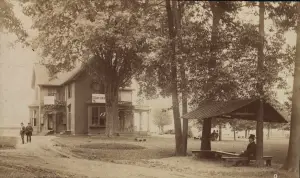As with many streets in towns and cities across the country, Alexandrine Street, where the El Moore is located, takes its name from a prominent citizen of the city’s past. Alexandrine Macomb Sheldon was born in Detroit in 1829, a descendant of the Macomb family, one of the founding families and land owners of Detroit.
She was married in 1847 to John Barnabas Campau, a member of another of Detroit’s founding families. During her marriage to Mr. Campau, she travelled extensively throughout Europe and, while in Paris, was presented to Napoleon III and the Empress Eugénie at the Tuileries Palace. She also managed to arrange private audiences with two popes, Pius IX and Pius X – these were clearly people of some influence!
Although she led a very privileged life, it wasn’t one without significant loss. She survived all four of her children, losing her two daughters at a very young age and her sons Thomas and Albert at the ages of 34 and 42, respectively. Then in 1859, her husband drowned in the Detroit River leaving her a widow at the age of 30.
Upon her husband’s death, she travelled to New York where she met and married Richard Storrs Willis in 1861 (Willis Street is most certainly named after him). Richard Willis was himself a widower with three very young daughters. He came from an influential Boston family who made their fortune in publishing. His was the brother of Nathaniel Parker Willis, a well known American poet, and they counted among their friends many artistic and influential people of the time, such as Henry Wadsworth Longfellow and Oliver Wendell Holmes. Willis was a graduate of Yale University and spent many years in Europe studying music composition in Germany under Felix Mendelssohn. Willis was a composer of hymns, and best known for having composed the music to the well-known Christmas carol, “It Came Upon a Midnight Clear”.
The Willis’ spent some years in Europe after their marriage; their children were educated there. Upon returning to America, they settled in Detroit because Alexandrine owned a fair amount of property here, including the southern 1/3 of Belle Isle which she had inherited from her first husband, Mr. Campau. The couple built a home on the island to use as a summer cottage and named it Inselruhe which, in German, means “island serenity.” That house still stands today near the southern end of the island and is known as the “White House.” They also had a substantial home located on Jefferson Avenue; that home is no longer standing.


Like many women of her day, Alexandrine was involved in philanthropic work and with the promotion of the arts. She was one of the founders of the old Detroit Museum of Art and the Detroit Philharmonic Orchestra. Mr. Willis continued his work in publishing and music composition while living in Detroit, but was also involved in real estate and land development which, along with their social prominence, can explain the naming of Alexandrine and Willis Streets.
Alexandrine Macomb Sheldon Campau Willis died in Detroit on March 28, 1910 at the age of 81 having survived all of her children and two husbands. The obituary in the Detroit Free Press described her as “an ornament of society”, having “regal bearing”, and “exquisite graciousness.” Many people, even those who were prominent in their day, seem to get lost to time, and I think most residents of this city have never heard of Alexandrine Willis. So I was all the more glad to take you on a brief journey into the past to get to know the lady from whom Alexandrine Street got its name.
